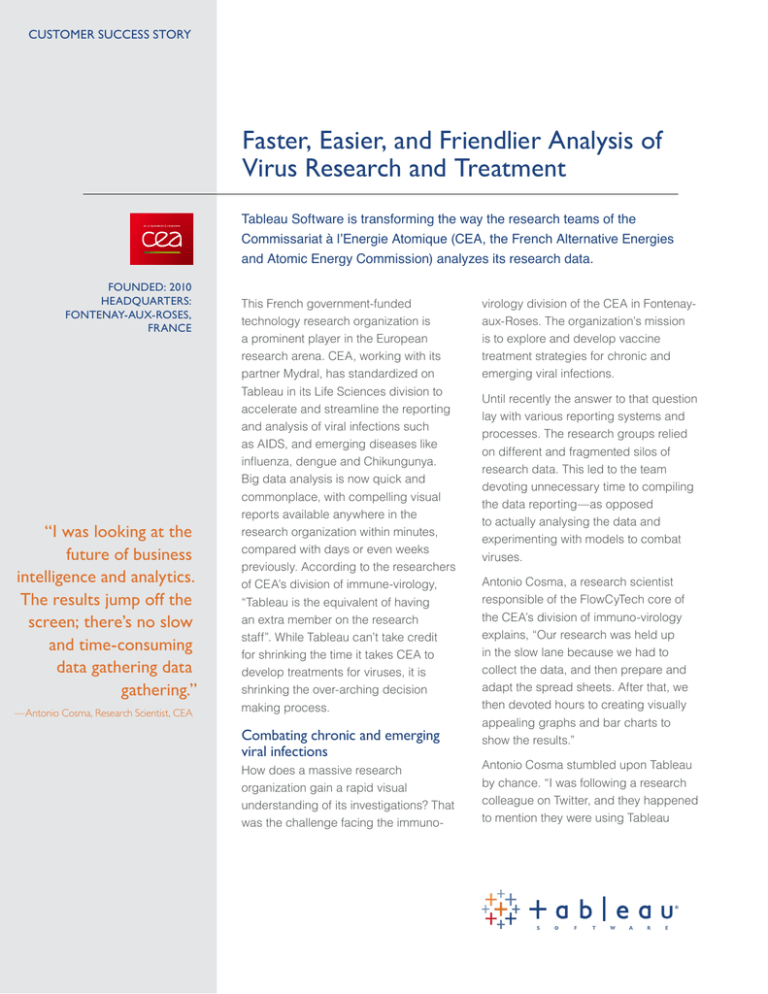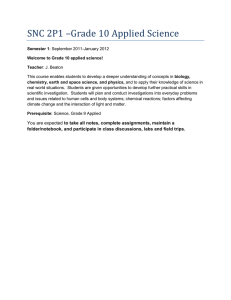Faster, Easier, and Friendlier Analysis of Virus Research and Treatment
advertisement

customer success story Faster, Easier, and Friendlier Analysis of Virus Research and Treatment Tableau Software is transforming the way the research teams of the Commissariat à l’Energie Atomique (CEA, the French Alternative Energies and Atomic Energy Commission) analyzes its research data. Founded: 2010 HEADQUARTERS: Fontenay-aux-Roses, France “I was looking at the future of business intelligence and analytics. The results jump off the screen; there’s no slow and time-consuming data gathering data gathering.” —Antonio Cosma, Research Scientist, CEA This French government-funded technology research organization is a prominent player in the European research arena. CEA, working with its partner Mydral, has standardized on Tableau in its Life Sciences division to accelerate and streamline the reporting and analysis of viral infections such as AIDS, and emerging diseases like influenza, dengue and Chikungunya. Big data analysis is now quick and commonplace, with compelling visual reports available anywhere in the research organization within minutes, compared with days or even weeks previously. According to the researchers of CEA’s division of immune-virology, “Tableau is the equivalent of having an extra member on the research staff”. While Tableau can’t take credit for shrinking the time it takes CEA to develop treatments for viruses, it is shrinking the over-arching decision making process. Combating chronic and emerging viral infections How does a massive research organization gain a rapid visual understanding of its investigations? That was the challenge facing the immuno- virology division of the CEA in Fontenayaux-Roses. The organization’s mission is to explore and develop vaccine treatment strategies for chronic and emerging viral infections. Until recently the answer to that question lay with various reporting systems and processes. The research groups relied on different and fragmented silos of research data. This led to the team devoting unnecessary time to compiling the data reporting—as opposed to actually analysing the data and experimenting with models to combat viruses. Antonio Cosma, a research scientist responsible of the FlowCyTech core of the CEA’s division of immuno-virology explains, “Our research was held up in the slow lane because we had to collect the data, and then prepare and adapt the spread sheets. After that, we then devoted hours to creating visually appealing graphs and bar charts to show the results.” Antonio Cosma stumbled upon Tableau by chance. “I was following a research colleague on Twitter, and they happened to mention they were using Tableau to visualize their data,” he explains. “The more I read about the solution, the more it became apparent that I was looking at the future of business intelligence and analytics. The results jump off the screen; there’s no slow and time-consuming data gathering data gathering.” “We’re used to asking for changes and then waiting several days for the adjusted report to be returned. Now it’s all done on the fly.” —Antonio Cosma, Research Scientist, CEA Live in minutes for big data intelligence Fuelled by what he had seen, Antonio Cosma installed a trial of the Tableau technology. Within minutes he was supporting his flow cytometry analysis and cell sorting with visual reporting. The cytometry platform examines, counts, and sorts up to 50,000 fluorescence-tagged cells per second, and is used to separate cells of interest to the CEA research team. Using Tableau, the CEA team integrates the vast amount of research data collected by the flow cytometry into a single visual analysis process. This allows Antonio Cosma and his team to quickly see patterns in their data and shift views instantly to follow their line of research. “Tableau is transforming the way we look at and analyze our research data,” he says. “We simply select the data we need and then anyone can instantly visualize the information in a multitude of different ways. We’re used to asking for changes and then waiting several days for the adjusted report to be returned. Now it’s all done on the fly.” Antonio Cosma cites one example of how CEA is using Tableau to streamline and accelerate the research process. “We use Tableau to control the quality of the instruments and materials we use in the labs. For instance, when we need to access an antibody stored in the fridge, Tableau points us immediately to which antibody is the most appropriate for the test, its reference, and its history.” Research questions involving big data answered immediately For CEA the big change using Tableau is in getting more answers, not more questions. “We are dealing with huge volumes of data as part of our viral infection research. Tableau makes that volume of big data transparent. It answers questions immediately, combining data exploration and visualization in one easy-to-use application that anyone on the team can learn quickly,” says Antonio Cosma. Anyone on the CEA team comfortable with Excel (and being scientists they are all comfortable!) can create interactive dashboards and share them securely across the organization. The team also has the flexibility to export highresolution images. This means they can add the visualizations directly into published research reports. “Tableau saves the CEA’s division of immune-virology days of work and is the equivalent of having one extra member of staff on the team,” Antonio Cosma adds. “Only last week for example, we needed to identify several individuals who were participating in a research study. We have thousands of candidates on our lists, but we didn’t spend hours trawling through spread sheet lists, the individuals were identified in seconds.” tableausoftware.com © Copyright Tableau Software, Inc. 2013. All rights reserved. Tableau Software, the Tableau Software logo, and Visual Analysis for Databases are either registered trademarks or trademarks of Tableau Software, Incorporated. Other company or product names may be the trademarks of their respective owners.




